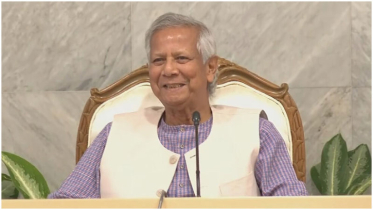Can Bangladesh become a semiconductor nation?
Global semiconductor industry is passing through exciting times, characterized by heightened expectations for market growth, accompanied by a rat-race to secure resources and talents to fend off any potential disruptions in the supply of microchips to the global technology machines. Fueled by relentless innovation in artificial intelligence-based computing solutions, automotive and miniature electronics, and Internet of Things (IOTs), resulting into enhanced usage of complex microchips or integrated circuits (ICs) in any device one can possibly imagine, the global market for chips is projected to grow, according to McKinsey estimates, to more than $1 trillion by 2030, from its current $600 billion annually.
Resurgent market demand and increased government incentives have led to upsurge in chip making foundries, expanding the global capacity at an unprecedented rate.
Due to this high potential growth in a relatively short future, there is going to be a lot more demand for chip making foundry, chip designing and packaging and testing capacities in the future. Though the semiconductor industry is also seeing new innovations in the way chip is developed and produced, the existing segmentation in front end and back end will command entry of new players, most likely gravitating to the existing geographic locations and allowing for new entrants too, particularly due to the economic and political need for diversifying the production base, compounded to a large extent by the fallout from the US-China geo-political tensions leading to the US-China chip war. Much of the growth will gravitate towards existing geographies, however new entrants such as India and Vietnam in the Asia region, are also taking initiatives to attract enhanced investment alluring global chip manufacturing companies with government sponsored incentives.
Bangladesh does not want to be left behind. Media reports indicate that the government desires to raise exports of semiconductor products to $10bn by 2031.
Bangladeshi chip design companies are currently engaged in chip design services to global companies. One may find it interesting that a Bangladeshi company, Ulkasemi, designed chips for big-name companies that included Apple too, being the largest and oldest Bangladeshi owned chip design services company. Ulkasemi started in Bangladesh and extended to Silicon Valley, and then to other global locations, such as in Ontario and Bengaluru. The company maintains a large design centre that adheres to strict quality and security protocols where a bustling team of Bangladeshi young engineers create chip design solutions for the global technology companies. Ulkasemi is a TSMC Design Center Alliance (DCA) partner, TSMC being the world’s largest producer of semiconductors and the main supplier of tech-companies, having 53% of global market share alone currently. In addition to being a partner of TSMC, Ulkasemi also works with almost all the major globally known foundries, which include Intel, Micron, Global Foundry, and Texas Instruments too.
Given the potential, Bangladeshi entrepreneurs and policy makers are seriously considering how Bangladesh can make a foray into the growing world market for semiconductors and related products. Admittedly, countries that can make an inroad into this industry will be the ones driving the world economies in the future years, as semiconductors are aptly considered the new “oil.”
The technology mix and the positioning within the value-chain targeting a product segment or segments will be a critical determinant for gradual evolution into a sustaining manufacturing base from an initial start point. According to an industry expert I met at an international semiconductor event, who holds a key position in one of the world’s top semiconductor equipment manufacturing companies, it is essential to locate the right “sweet spot” for entry. Given that the semiconductor industry is extremely knowledge intensive and sensitive to complex technology know-how and skills, and the right ecosystem that supports the industry is essential for potential success. One of the important elements is the supply network of the support vendors. In our neighbouring country, India, vendors are now creating presence, however it may be costly to have such a network unless there is an existing industry base or a critical mass of customers.
Establishing fabrication foundries, or fabs in short, requires substantial capital investments, necessitating thorough research and evaluation before committing resources. Due to the high cost and complexity of wafer fabrication, semiconductor has historically been concentrated in a few key geographies where a robust ecosystem supported the agglomeration of semiconductor firms. Countries with established semiconductor industries have developed extensive infrastructure, economies of scale, and government support, including financial incentives and intellectual property protection.
The manufacturing industry is divided into two primary stages: the front end (wafer fabrication) and the back end (assembly, testing, and packaging). The front end is more automated and capital-intensive, whereas the back end is labour-intensive.
Geopolitical tensions, particularly between the US and China, are prompting semiconductor companies to reconsider and diversify their production locations. Global consulting company, Kearney, in an analysis of Front-End Semiconductor Manufacturing Attractiveness Index, highlights three major factors influencing fab location decisions:
- Business environment: Includes legal/regulatory frameworks, intellectual property protection, innovation outlook, and availability of skilled talent.
- Incentives: Governments offer various incentives to attract semiconductor companies, such as tax breaks, subsidies, and utility deals.
- Operating costs: Considers labour, utilities, and supply chain expenses crucial for the long-term viability of fab operations.
Among the established front-end manufacturing hubs, ie fabrication foundry countries, Taiwan and South Korea remain in the top spots of the attractiveness index, currently accounting for a total of 63% of the global semiconductor market, including all kinds of foundries. The high-end Asian alternatives are Japan and Singapore. Both have a high technology ecosystem and high government subsidy programmes, however none can match the cost advantages of Taiwan and South Korea. Among the established Western countries, the United States, Germany and France are the frontrunners, however these countries have some of the highest operating costs, nearly 40 % more than their Asian counterparts. Malaysia is among the top five countries, and has been branded as the low-cost overachiever by Kearney.
Among the emergent destinations that are poised as promising options for front-end manufacturing, India and Vietnam top the list considering the factors influencing the attractiveness index. These countries compensate for their lack of front-end fabrication experience and comparatively less robust business environments by offering generous subsidies and relatively low operational costs.
Industry analysts consider that now is the best time to make a foothold in the industry as there is unprecedented demand for new fabs and services, and many countries which are investing in capacity development at present will end up as gravitational geographies where the industry will likely locate in the future years. The agglomeration economies benefit the current industrial base of Malaysia in electric and electronics, South Korea and Taiwan in semiconductors -- these three countries have benefitted in the recent years from their respective comparative advantages in the cited sectors, which were cultivated through targeted policies and practices.
From the heydays of geographic concentration in a few hubs, the enhanced demand for chips have led to increased fragmentation and geographical dispersal in chip productions, compounded by global factors related to the geo-political tensions mentioned above. As a result, the global market for semiconductor is witnessing new entrants leading to growth in production of chips and services, and the semiconductor producing countries are pursuing their efforts to create conducive ecosystems to grab enhanced share of the chip market.
There are reasons to be optimistic about the future of the industry, nevertheless there are inherent risks too, since the technology in the semiconductor value-chain is extremely complex, only a few countries and companies could master the know-how and build super-charging ecosystems. In the race to create footholds, the countries will be required to continuously assess evolving market conditions and devise strategies to adapt to the new market conditions.
How Bangladesh can grab a share
Bangladesh was not included in the list of attractive countries for front-end manufacturing, arguably due to the relative absence of the factors influencing the attractiveness index. However, this is front-end manufacturing or foundry, Bangladesh will be better off focusing on the back-end, ie packaging and testing, and chip design segment. Bangladesh already has a chip design service industry, though a miniscule of the globally almost $50bn, which is projected to grow to more than $84bn by 2030. Among the few players, Ulkasemi has been able to achieve the crowning success, being the oldest and the largest in Bangladesh, as mentioned above. The founder and owner is a Bangladeshi American based in Silicon Valley and a veteran of the chip design industry, who gained long experience working in AMD and few start-up companies. Ulkasemi’s technology prowess and market network gained considerable traction and the company leads the way into the chip design services from the heartland of Bangladesh to the world of tech-companies globally.
Given this head-start, Bangladesh can utilize the experience in chip design gained by Ulkasemi and others, to augment the size of the industry and train more and more engineers suited for work in the chip design services industry. Unlike the manufacturing segment of the chip industry value-chain, there are relatively low barriers to entry in the chip design services market and the scale of investment needed to make a headway is relatively lower than the staggering capitals required for a foundry and packaging and testing industry. Of course, the human capital and market network have to be there to gain traction. Bangladeshi diaspora, particularly professionals who gained significant experience in working with semiconductor companies, potentially can be instrumental in making a breakthrough.
Manufacturing of chips are highly complex and within the value chain, the process from inception of design to final testing are usually segmented in industry language as pre-fab, fab and post-fab. Pre-fab would involve design of chips for an intended product application, fab would involve actual fabrication of wafers with ICs and finally, post-fab would involve packaging and testing. There have been shifts towards newer paradigms of manufacturing, where integrated manufacturing within system foundries produces chips in a compound fashion without segmenting the manufacturing process into the three known stages of design, fabricate, and package and test indicated above.
The entry
If Bangladesh wants to establish a foothold in chip manufacturing, the country’s policies must focus on building a robust ecosystem and ensuring readiness for the industry. A crucial ingredient is the development of a skilled human talent base. Additionally, government incentives, supportive infrastructure -- such as reliable electricity and water supply -- and the presence of supportive companies within the industry's supply chain are essential factors for success. To achieve an ambitious goal of becoming a semiconductor nation, a coordinated effort involving industry, academia and the government will be essential.
The entry “sweet spot” for Bangladesh in the semiconductor industry is likely to be in packaging and testing (the back-end in manufacturing) rather than fabrication of wafer. As mentioned above, fabrication requires significantly larger investments and a more advanced technical support system, which could pose substantial challenges and deter potential investors from taking such risks. Therefore, Bangladesh may be better off devising strategies and policies to attract investors into chip design, talent creation for the local and global market, and focus on drawing investment for packaging and testing or the Outsourced Semiconductor Assembly and Test (OSAT) segment of the semiconductor production cycle.
In addition to attracting the big investors in the semiconductor value-chain, particularly in packaging and testing, we also have to create policies to allow the support industry or backward linkage firms to enter the market and develop too. The relationship and networking with globally successful companies will be important for access to market and technology transfer. Therefore, we must adopt policies to facilitate easy mobility with locations in Asia such as Taiwan and Malaysia and with the Western-behemoths. Currently, Taiwan leads the manufacturing industry globally, however, Bangladesh has no visa arrangement with Taiwan. China, being the most successful country outside the US centric production hubs, may be of great support to create and develop the industry in our country. China has mastered the art and science of manufacturing, and offers manufacturing technologies at much less cost than the other advanced semiconductor equipment manufacturing countries.
Drawing investment from global companies will mean doing our own due diligence of the attractiveness of Bangladesh as a potential investment location. Global companies will consider other options and will evaluate how existing investors are generating returns and viewing Bangladesh as an investment location. If there are issues that need to be addressed, then the government and the private sector will need to work collaboratively and devise ways to eradicate those stress points for investors.
For Bangladesh to create a niche in the semiconductor industry within its borders, collaboration is essential. It would be beneficial to assess where we can complement the capabilities of other countries and how such collaboration can lead to a mutually beneficial model of value creation. For example, Malaysia has announced an ambitious plan to develop the chip design talent, and Bangladesh can play a strong complementary role in achieving the targets by training local talents. The talent base is currently in significant shortage across all semiconductor-producing countries. Given the specialized skills required, this shortage has created a global race for talent, surmounting traditional mobility restrictions. In addition, training potential engineers and technical support talents through coordinated training and resource sharing among universities and government labs will likely be productive and fruitful.
With a population base of young ambitious people who are fast-learners and can be trained with appropriate skills for the semiconductor industry, the shortage created an opportunity to enter the market now. If we miss the opportunity now, then it may not be easily possible to enter at a later stage since collaboration for talent development and dispersion of production hubs are more likely to happen within the current contextual reality, leading to a new equilibrium of agglomeration for production hubs.
Source: Dhaka Tribune.
.png)




